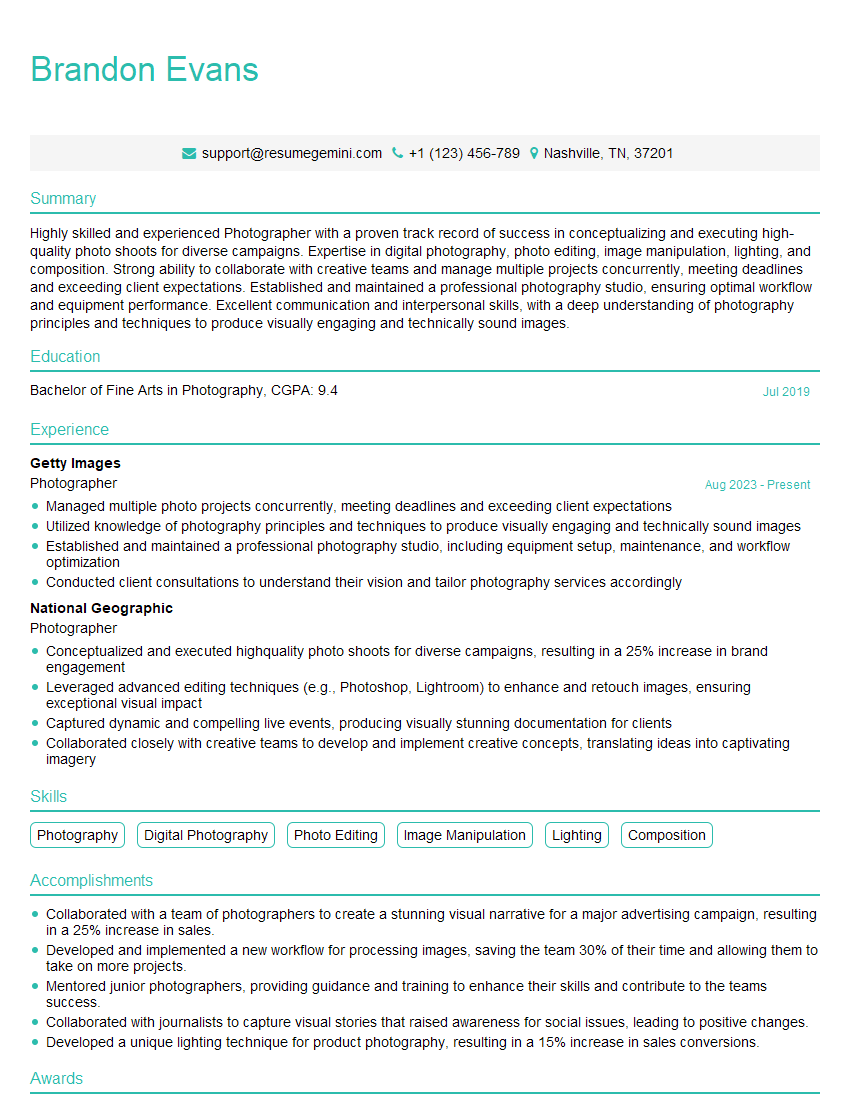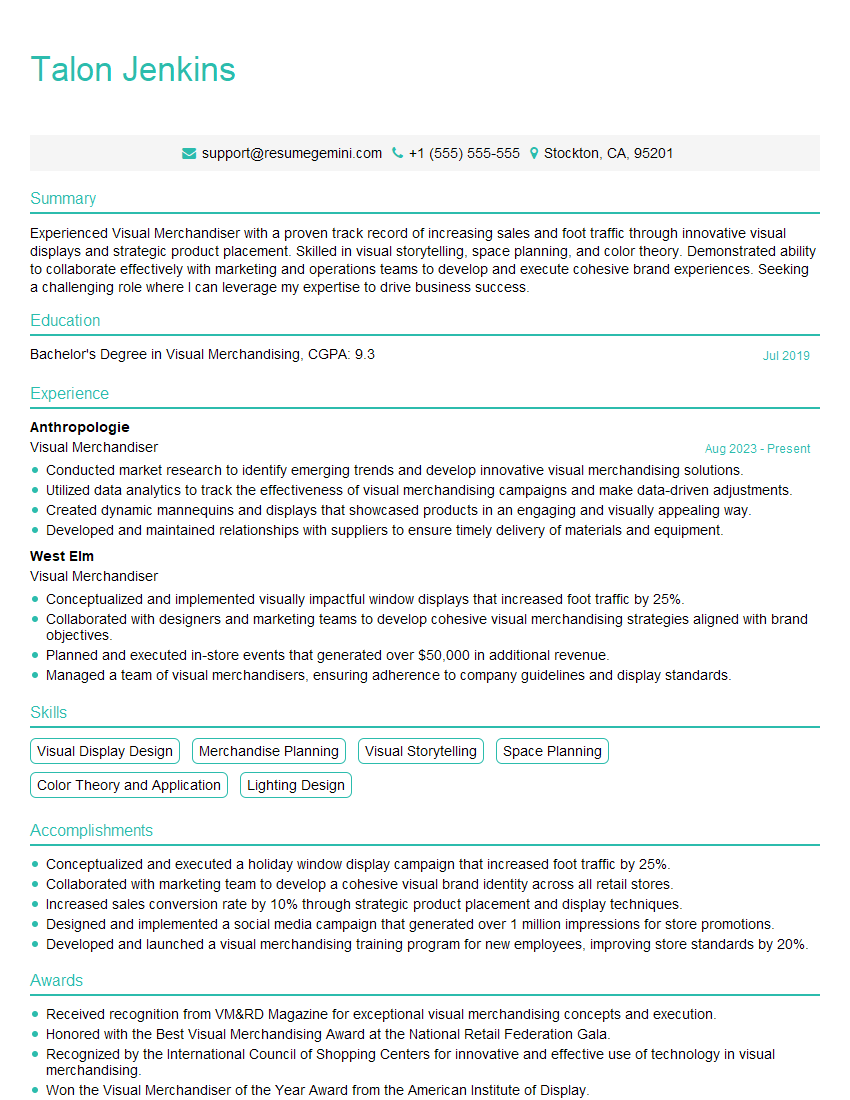The right preparation can turn an interview into an opportunity to showcase your expertise. This guide to Understanding of Color Perception interview questions is your ultimate resource, providing key insights and tips to help you ace your responses and stand out as a top candidate.
Questions Asked in Understanding of Color Perception Interview
Q 1. Explain the difference between additive and subtractive color mixing.
Additive and subtractive color mixing are two fundamentally different approaches to creating colors. Think of it like this: additive is about adding light, while subtractive is about subtracting light.
Additive color mixing occurs when light sources of different colors are combined. The primary colors in additive mixing are red, green, and blue (RGB). When you combine these primary colors in equal amounts, you get white light. This is how your computer monitor or television creates color; each pixel is a combination of red, green, and blue subpixels. For instance, combining red and green light produces yellow light. The more light you add, the brighter the resulting color becomes.
Subtractive color mixing, on the other hand, involves mixing pigments or inks. The primary colors here are cyan, magenta, and yellow (CMY), along with black (K) to improve the dark tones. These pigments absorb certain wavelengths of light, reflecting only the remaining wavelengths that create the perceived color. When you mix all the subtractive primary colors, you get black, as all wavelengths of light are absorbed. This is how color printing works; cyan, magenta, yellow, and black inks are used to reproduce images on paper.
- Additive: Light sources (e.g., screens, projectors)
- Subtractive: Pigments, inks (e.g., printing, painting)
Q 2. Describe the three main color models (RGB, CMYK, LAB) and their applications.
Three major color models are crucial in digital imaging and printing: RGB, CMYK, and LAB.
- RGB (Red, Green, Blue): This is an additive color model used for displaying colors on screens. Each color is represented by a value ranging from 0 to 255 (or 0 to 1 in normalized form), representing the intensity of each primary color.
(255, 0, 0)represents pure red,(0, 255, 0)pure green, and(0, 0, 255)pure blue. This is the dominant color model for digital photography, video, and web design. - CMYK (Cyan, Magenta, Yellow, Black): This is a subtractive color model primarily used in printing. It’s based on the pigments used in inks. Black (K) is added to improve the quality of dark tones and reduce the amount of other inks needed. Applications include printing posters, books, and magazines.
- LAB (L*a*b*): This color model is device-independent, meaning it aims to represent colors perceptually uniformly. ‘L’ represents lightness, ‘a’ represents the green-red opponent channel, and ‘b’ represents the blue-yellow opponent channel. It’s used where color accuracy is paramount, like in color management systems and for calibrating monitors. It’s often used as an intermediary color space for conversions between RGB and CMYK to ensure color consistency across different devices.
Choosing the right model depends on the application. For screens, use RGB; for print, use CMYK; and for color management and ensuring consistency across different devices, LAB is the preferred option.
Q 3. What is color gamut, and why is it important in design and printing?
Color gamut refers to the range of colors that a particular device or system can reproduce. Think of it as the ‘color vocabulary’ of a device. A wider gamut means a device can display or print a greater variety of colors.
Importance in Design and Printing:
- Design: Designers need to be aware of the gamut of the target output device. Designing with colors outside the gamut of the final output (e.g., printing a design meant for a high-gamut screen on a standard printer) will lead to color shifts and inaccurate color reproduction. The design might appear duller or different from the original intent.
- Printing: Printing processes have limitations in reproducing the full range of colors visible to the human eye. Understanding the gamut of the printing process is crucial for achieving accurate color reproduction in print. Color management systems are used to translate colors from a design’s color space to the printer’s gamut, minimizing color discrepancies.
For instance, a high-end printer with a wide color gamut will reproduce a vibrant image more accurately than a consumer-grade printer. In digital design, knowing the color gamut of the screen and the target print device is essential for visual consistency.
Q 4. Explain the concept of color temperature and its impact on visual perception.
Color temperature describes the appearance of a light source, measured in Kelvin (K). It essentially tells us whether a light source appears ‘warm’ or ‘cool’.
Lower Kelvin values (e.g., 2700K) indicate warmer colors, tending towards orange and red, like a candlelight or incandescent bulb. Higher Kelvin values (e.g., 6500K) indicate cooler colors, leaning towards blue, like daylight or LED lights.
Impact on Visual Perception: Color temperature significantly influences our perception of a scene’s mood and atmosphere. Warm light often creates a feeling of coziness and relaxation, while cool light can feel more stimulating and modern. The choice of color temperature is crucial in design, photography, and videography to evoke specific emotional responses.
For example, a warm-toned restaurant might use warmer lighting to create a comfortable atmosphere, while a modern office might prefer cooler lighting to foster a more productive environment.
Q 5. What is color constancy, and how does it affect our perception of color?
Color constancy is our visual system’s ability to perceive the color of an object as relatively constant even under varying lighting conditions. Our brains compensate for changes in illumination, allowing us to recognize a red apple as red whether it’s lit by sunlight or a dim lamp.
How it Affects Perception: Color constancy is crucial for our everyday perception because it allows us to recognize objects consistently regardless of the lighting environment. Without it, the color of objects would drastically change depending on the light source, making it difficult to identify objects reliably.
However, color constancy isn’t perfect. It can be affected by factors such as the surrounding colors and the intensity of the light. For instance, under very unusual lighting conditions, our perception of color might be slightly off, leading to minor discrepancies in color recognition.
Q 6. Discuss the impact of lighting conditions on color perception.
Lighting conditions profoundly impact color perception. The spectral power distribution of the light source (the intensity of different wavelengths) directly influences how colors appear. Different light sources emit light with different spectral compositions.
For instance, incandescent light has a higher proportion of longer wavelengths (reds and yellows), creating warmer tones, while daylight has a more even spectral distribution, producing more neutral colors. Fluorescent lights often have a higher proportion of blue light, making colors appear cooler.
Impact on Design and Photography: Understanding the impact of lighting is vital in several fields. In photography, using a color temperature meter ensures accurate color reproduction. In interior design, lighting choice affects the perceived color of walls and furniture; warm light can make a room feel cozier, while cool light can make it feel more spacious.
Q 7. Describe different types of color vision deficiency (color blindness).
Color vision deficiency (CVD), often called color blindness, refers to the reduced ability to distinguish between certain colors. It’s typically caused by genetic mutations affecting the photoreceptor cells (cones) in the retina.
Types:
- Protanopia: Difficulty distinguishing red from green. Red cones are missing or malfunctioning.
- Deuteranopia: Difficulty distinguishing red from green. Green cones are missing or malfunctioning.
- Tritanopia: Difficulty distinguishing blue from yellow. Blue cones are missing or malfunctioning. This is less common than protanopia and deuteranopia.
- Monochromacy: Very rare condition where individuals see only shades of gray. They have no functional cones.
The severity of CVD varies. Some individuals have mild difficulty distinguishing certain color shades, while others have more severe impairments. Understanding CVD is essential for accessible design, ensuring that color isn’t the sole method used to convey important information.
Q 8. How can you ensure color accuracy across different devices and media?
Ensuring color accuracy across different devices and media is crucial for consistent brand identity and user experience. It’s a challenge because devices have varying color spaces and display technologies (e.g., sRGB, Adobe RGB, DCI-P3). To overcome this, we use color management systems. This involves several key steps:
- Working in a Wide Gamut Color Space: Start your design process in a wide-gamut color space like Adobe RGB or ProPhoto RGB. These spaces offer a broader range of colors than sRGB, providing more flexibility and preventing color clipping (loss of color information) when converting to smaller color spaces later.
- Color Profiling: Create color profiles for your monitors and printers. A color profile acts like a translator, mapping the colors your device displays or prints to a standardized color space. This allows for a more accurate representation of the colors intended.
- Using Color Management Software: Employ software like Adobe Color Engine or similar tools within design programs to manage the conversion between color spaces. These tools ensure your colors translate as accurately as possible from your design to various outputs.
- Converting to Targeted Color Spaces: When preparing files for print, web, or specific devices, use the correct color space for the target output. For example, use sRGB for web and a CMYK profile for print. Don’t blindly convert – check your colors!
- Proofing: Always soft-proof your work on screen, simulating the target output’s color space. This allows you to catch potential color discrepancies before printing or publishing. A hard-proof (a physical print) is helpful for final verification, especially for critical applications.
Imagine designing a vibrant logo: If the color is accurately represented on your screen but appears dull when printed, it’s a failure of color management. By following these steps, the logo’s colours will remain true to your vision across all platforms.
Q 9. Explain the principles of color harmony and contrast.
Color harmony and contrast are fundamental principles in design. Harmony creates a visually pleasing and unified look, while contrast draws attention to specific elements.
- Color Harmony: This involves using colors that are visually compatible. Common harmonies include:
- Analogous: Colors that sit next to each other on the color wheel (e.g., blue, blue-green, green). They create a calm and serene feel.
- Complementary: Colors opposite each other on the color wheel (e.g., red and green). They offer high contrast and visual excitement.
- Triadic: Three colors evenly spaced on the color wheel (e.g., red, yellow, blue). They provide a balanced and vibrant palette.
- Split-Complementary: One color and the two colors adjacent to its complement (e.g., blue, orange-red, yellow-orange). It offers a good balance between harmony and contrast.
- Color Contrast: This refers to the difference between colors, enhancing readability and visual impact. High contrast is useful for text on a background (black text on a white background is high contrast). Low contrast might be used for a softer, more subtle aesthetic.
For instance, a website using analogous colors (blues and greens) might evoke a feeling of tranquility, whereas one using complementary colors (red and green) might be more striking. The effective use of both harmony and contrast ensures both visual appeal and clarity.
Q 10. How does color psychology influence design choices?
Color psychology studies how colors evoke emotions and influence behavior. This significantly impacts design choices. Different colors trigger different associations:
- Red: Energy, passion, urgency. It’s often used for calls to action.
- Blue: Trust, calm, stability. Commonly used for corporate brands.
- Green: Nature, growth, health. Ideal for environmentally-focused brands.
- Yellow: Happiness, optimism, creativity. Can be used to attract attention but should be used sparingly, as too much can be overwhelming.
- Purple: Royalty, luxury, creativity. Often associated with high-end brands.
For example, a children’s toy company might use bright, cheerful colors like yellow and orange to convey playfulness, while a financial institution might prefer blue and green to project stability and trustworthiness. Understanding color psychology enables designers to strategically select colors to elicit specific emotional responses from their target audience, enhancing the effectiveness of their designs.
Q 11. What are some common color palettes, and what emotions or messages do they convey?
Numerous color palettes exist, each conveying unique emotions and messages:
- Monochromatic: Uses various shades and tints of a single color. Creates a sophisticated and unified look (e.g., different shades of blue).
- Analogous: Uses colors adjacent on the color wheel. Creates a harmonious and serene feel.
- Complementary: Uses colors opposite each other on the color wheel. Creates high contrast and visual interest.
- Triadic: Uses three colors evenly spaced on the color wheel. Provides a vibrant and balanced palette.
- Warm Palettes (reds, oranges, yellows): Convey energy, excitement, and warmth.
- Cool Palettes (blues, greens, purples): Communicate calmness, serenity, and sophistication.
Consider a website for a spa: a cool palette of blues and greens would align with relaxation and tranquility, whereas a website for a fast-food restaurant might employ a warm palette of reds and yellows to generate a sense of energy and appetite.
Q 12. How do you choose appropriate colors for a specific target audience?
Choosing appropriate colors for a specific target audience requires understanding their demographics, psychographics, and cultural backgrounds. Research and data analysis play a critical role:
- Market Research: Analyze existing branding, competitor analysis, and target audience preferences. This might involve surveys, focus groups, or reviewing existing data.
- Demographics: Consider age, gender, location, and socioeconomic status. Certain colors resonate more strongly with particular demographics.
- Psychographics: Examine values, lifestyles, attitudes, and interests. This helps understand what colors align with the target audience’s personality and worldview.
- Cultural Considerations: Colors hold different meanings across cultures. For example, white signifies purity in Western cultures, but mourning in some Eastern cultures.
- A/B Testing: After initial design, test different color variations to measure which resonates best with the audience. Data-driven decisions are crucial.
For example, designing a marketing campaign for teenagers might involve using brighter, bolder colors associated with youth culture, whereas a campaign targeting older adults might use a more subdued and sophisticated palette.
Q 13. Describe your experience with color management software.
My experience with color management software includes extensive use of Adobe Color Engine, integrated within Adobe Creative Suite applications (Photoshop, Illustrator, InDesign). I’m proficient in creating and applying color profiles, converting between color spaces (RGB, CMYK, LAB), and utilizing soft-proofing capabilities to ensure color accuracy across different outputs. I also have experience with other color management tools, such as X-Rite i1Profiler for creating accurate monitor and printer profiles. My work regularly involves color adjustments, color space conversions and dealing with potential color discrepancies between print and screen outputs.
I’ve successfully managed color for various projects, including website design, print marketing materials, and product packaging. In one instance, I helped a client achieve consistent brand colors across their website, brochures, and trade show booth graphics using Adobe Color Engine, avoiding costly reprint errors.
Q 14. Explain the concept of color profiling.
Color profiling is the process of creating a characterization of a device’s color response. It’s like creating a detailed map of how a particular device (monitor, printer, scanner) reproduces colors. Each device has a unique color profile because of variations in manufacturing and settings. A color profile allows other applications and devices to accurately interpret the colors generated by that device.
Color profiles use data to translate between device-specific colors and a standardized color space (like sRGB or Adobe RGB). This ensures that the colors you see on your monitor are as close as possible to how they will appear on another monitor, on a print, or on the web. Without color profiles, the same color data could lead to wildly different results on different devices.
For example, a photographer will use a color profile for their camera to ensure accurate color representation in their images. Similarly, a designer will use profiles for their monitor and printer to match their on-screen view to the final printed result. Color profiling is essential for color accuracy and consistency across the design and production workflow.
Q 15. How do you handle color discrepancies between design and print?
Color discrepancies between design and print are a common challenge stemming from the differences in how color is represented and reproduced on screens versus printed media. Screens use additive color mixing (RGB), while print uses subtractive color mixing (CMYK). To mitigate this, several steps are crucial:
- Accurate Color Profiles: Using accurate color profiles for both your monitor (e.g., using a colorimeter for calibration) and your printing device is essential. This ensures a consistent interpretation of color across devices.
- CMYK Conversion: When preparing files for print, ensure a proper conversion from RGB (screen) to CMYK (print). This often involves software like Adobe Photoshop or Illustrator, and skilled color management is key for accurate transformation.
- Soft Proofing: Soft proofing simulates the printed output on screen, allowing for adjustments before actual printing. This is incredibly valuable in catching potential discrepancies before they become costly reprints.
- Print Proofs: Ordering a color proof from your print provider is invaluable. This physical proof allows for a final color check before mass production, catching subtle nuances that digital previews might miss.
- Communication: Open and clear communication with your printer is critical. Discuss color expectations, desired paper stock, and potential color variations due to paper absorption or ink limitations.
For instance, a vibrant RGB green might appear duller as a CMYK green due to ink limitations. Understanding this and adjusting the design accordingly is crucial for achieving the desired results.
Career Expert Tips:
- Ace those interviews! Prepare effectively by reviewing the Top 50 Most Common Interview Questions on ResumeGemini.
- Navigate your job search with confidence! Explore a wide range of Career Tips on ResumeGemini. Learn about common challenges and recommendations to overcome them.
- Craft the perfect resume! Master the Art of Resume Writing with ResumeGemini’s guide. Showcase your unique qualifications and achievements effectively.
- Don’t miss out on holiday savings! Build your dream resume with ResumeGemini’s ATS optimized templates.
Q 16. What are some common color space transformations, and when are they used?
Color space transformations are crucial for moving color data between different systems, such as from RGB to CMYK, or from one RGB space (like sRGB) to another (like Adobe RGB). Common transformations include:
- RGB to CMYK: As mentioned, this is essential for print. It involves converting additive color (RGB) to subtractive color (CMYK). The conversion isn’t always perfect; some colors might not translate accurately.
- sRGB to Adobe RGB: This is often used for photography and digital design. Adobe RGB has a wider gamut, meaning it can represent more colors than sRGB. Transforming to Adobe RGB can retain more color information, but it’s important to consider how this will be displayed on devices that use sRGB.
- XYZ to other color spaces: XYZ is a device-independent color space. Transformations to and from XYZ are fundamental in managing and converting between different color systems, ensuring that colors are consistent across diverse technologies.
- Lab to RGB/CMYK: Lab (CIE L*a*b*) is a perceptually uniform color space; this means that equal numerical differences in Lab values correspond to roughly equal visual differences. Converting to or from Lab can be beneficial for adjusting color balance without drastically altering the overall look.
The choice of transformation depends on the specific application. When preparing images for web use, sticking to sRGB is usually best, while for print, accurate CMYK conversion is paramount. Accurate transformations require utilizing color management software and profiles for optimal results.
Q 17. Explain your understanding of Pantone Matching System (PMS).
The Pantone Matching System (PMS) is a standardized color reproduction system that uses proprietary ink formulations for precise color matching across various printing methods. Each PMS color has a unique number, allowing designers and printers to communicate and reproduce specific colors consistently.
Unlike RGB or CMYK, PMS colors are defined by specific ink recipes, not by a device’s ability to display or print them. This makes PMS especially valuable in situations where precise color is vital, such as branding, corporate identity, and packaging. For example, ensuring that a company logo is reproduced identically on a business card, a brochure, and a billboard requires the precision of PMS colors.
However, PMS colors are often more expensive to print than CMYK colors because they require special inks. Also, the exact color can vary slightly depending on the printer and paper stock used, so color proofing remains crucial.
Q 18. How do you ensure accessibility of color choices for visually impaired users?
Ensuring color accessibility for visually impaired users is crucial for inclusive design. This involves considering:
- Sufficient Contrast: Sufficient contrast between text and background colors is vital for readability. Tools and guidelines, like the WCAG (Web Content Accessibility Guidelines), specify minimum contrast ratios to ensure accessibility. For example, using a dark text on a light background or vice-versa is crucial.
- Color Blindness Simulation: Using tools that simulate color blindness allows designers to preview how their color choices affect users with different types of color vision deficiencies. This helps to avoid combinations that might be difficult to distinguish.
- Alternative Text and Descriptions: Providing descriptive text or alternative content for images and graphics that rely heavily on color is critical, ensuring users who are unable to perceive colors properly still gain the information presented.
- Beyond Contrast: Consider other visual cues in addition to color, such as size, shape, and spacing. The more visual redundancy there is, the better the design will serve a wider range of users.
For instance, simply using different colors to distinguish elements on a website is not sufficient; it needs to have alternative ways of differentiating these elements for color-blind users, such as using textures, icons, or different text labels.
Q 19. Describe a time you had to solve a color-related problem. What was your approach?
In a previous project designing a product packaging, we encountered a significant color mismatch between the design approved on screen and the initial print samples. The client’s signature turquoise was drastically different from what we had approved.
My approach involved a systematic investigation. First, we analyzed the color profiles used in the design software and the printing process. We discovered a discrepancy in color profiles—the designer had used Adobe RGB, while the printer had converted to CMYK using a generic profile instead of a custom profile tailored to their specific inks and paper.
Next, we worked with the printer to create a custom CMYK profile accurately reflecting their process. We then created soft proofs using this profile, allowing for a closer approximation of the final printed color. Finally, we generated a Pantone color matching the client’s desired shade and ensured the printer utilized that PMS code for all future printing.
This iterative process, involving thorough profile analysis, communication with the printer, and multiple rounds of proofs, successfully resolved the color issue and ensured consistent color reproduction across all production runs.
Q 20. What are your preferred methods for calibrating monitors and other display devices?
For accurate color calibration, I rely on hardware and software solutions. My preferred methods include:
- Colorimeter or Spectrophotometer: These devices measure the actual color output of the monitor or other display devices. They provide precise data for calibrating your display. Datacolor SpyderX and X-Rite i1Display Pro are reliable options.
- Calibration Software: Software like Datacolor’s SpyderX Pro or X-Rite’s i1Profiler uses the colorimeter data to create a custom profile for your monitor. This profile tells your operating system how to interpret and render colors accurately.
- Regular Calibration: I recommend calibrating monitors at least once a month, or even more frequently if working with critical color accuracy. Screen technology drifts slightly over time.
- Consistent Lighting Conditions: Calibrating in a controlled environment with consistent lighting is vital for accuracy. Avoiding direct sunlight or artificial light variation is crucial.
Calibration is not limited to monitors. Printers and even scanners benefit from profiling to improve color consistency across the entire workflow. Remember, a well-calibrated workflow ensures that what you see on screen closely matches the final printed output.
Q 21. Explain the difference between hue, saturation, and brightness/value.
Hue, saturation, and brightness (or value) are the three main attributes that define a color. They are often represented in the HSB or HSV (Hue, Saturation, Brightness/Value) color model:
- Hue: This refers to the pure color—the shade of the color you’re looking at. Think of it as the position on the color wheel (e.g., red, green, blue, yellow).
- Saturation: This refers to the intensity or purity of the color. A highly saturated color is vivid and intense, while a less saturated color is more muted or grayish. Imagine a pure red versus a red mixed with gray.
- Brightness/Value: This refers to the lightness or darkness of the color. High brightness means a light color (close to white), and low brightness means a dark color (close to black). Think of a light pastel pink versus a dark, deep crimson.
Understanding these attributes is crucial for effective color manipulation in design and image editing. For instance, you might adjust the saturation to make a color more intense or change the brightness to create various shades of a single hue.
Q 22. How would you explain the concept of color to someone with no prior knowledge?
Color, at its simplest, is our perception of different wavelengths of light. Imagine a rainbow – each color represents a different wavelength, from the longer wavelengths of red to the shorter wavelengths of violet. What we see as ‘color’ is our brain’s interpretation of these wavelengths after they’ve been processed by our eyes. We have specialized cells in our retinas called cones that are sensitive to different wavelengths, and the combination of signals from these cones creates our experience of color. Different combinations of these signals lead to the perception of millions of different hues.
Think of it like a painter mixing paints: Red and blue make purple; red and yellow make orange. Similarly, the combination of light wavelengths creates the vast spectrum of colors we perceive.
Q 23. How do you stay up-to-date with the latest trends and advancements in color technology?
Staying current in color technology requires a multi-pronged approach. I regularly read industry publications like Color Research & Application and attend conferences like the CIE (International Commission on Illumination) meetings. These events often showcase cutting-edge research in color science, new color measurement techniques, and advancements in color reproduction technology. Furthermore, I actively participate in online communities and forums dedicated to color management and graphic design, engaging in discussions and learning from other experts. I also follow leading researchers and companies in the field on platforms like LinkedIn and Twitter for the latest updates on emerging trends.
Q 24. Discuss your experience working with color in a specific project. What were the challenges and how did you overcome them?
In a recent project involving the design of a new product line, color consistency was paramount. We needed to ensure that the colors displayed on the website matched the colors printed on packaging and the colors of the physical product itself. The challenge arose from the varying color profiles of different screens (RGB) and print media (CMYK). Slight variations in color reproduction were inevitable.
To overcome this, we implemented a rigorous color management workflow. We began by defining a core color palette using a spectrophotometer to capture precise color measurements of the physical product. Then, we created ICC profiles (International Color Consortium) for both our screen and print outputs, ensuring accurate color transformation between RGB and CMYK. We also conducted extensive color proofing to minimize discrepancies. Regular calibration of our monitors was crucial, and we worked closely with the printing facility to ensure their equipment was properly profiled. This meticulous process minimized color differences, resulting in a visually consistent brand across different mediums.
Q 25. What tools and techniques do you use for color selection and management?
My color selection and management process relies on a combination of tools and techniques. For color selection, I often use Adobe Color, which offers a user-friendly interface for exploring color harmonies and creating palettes. I also rely heavily on Pantone color guides for accurate and consistent color communication across different stages of a project. For management, I utilize color management software, such as X-Rite Color i1Profiler, to create and utilize ICC profiles. This software allows me to profile my monitors and printers, ensuring consistent color reproduction across different devices.
In addition to software, I often use physical Pantone books as a reference point for clients or designers, allowing for hands-on color selection and providing a tangible representation of color choices. For digital work, a calibrated monitor is absolutely critical.
Q 26. How familiar are you with different color measurement instruments (e.g., spectrophotometer)?
I am highly familiar with various color measurement instruments, most notably spectrophotometers. I have extensive experience using spectrophotometers to measure and quantify the color of different materials and surfaces, including printed materials and physical products. Understanding the principles of colorimetry, including CIE L*a*b* color space, is crucial for accurate color measurements. Spectrophotometers provide objective color data, allowing for precise color matching and quality control throughout the design and production process. I also have experience with densitometers for measuring ink density and other color assessment tools.
Q 27. Describe your approach to creating a consistent color palette across multiple design elements.
Creating a consistent color palette across multiple design elements requires careful planning and execution. I typically start by defining a core palette – usually 3-5 main colors – that embody the brand’s personality and aesthetic. These colors are then used as a foundation for all subsequent design elements. To maintain consistency, I use a digital color palette, often in a format like Adobe Swatch Exchange (.ase), that can be easily shared and accessed across different design software. This ensures everyone involved is using the same precise color values. In addition to the core palette, I might create a set of supporting colors, ensuring that all variations remain harmonious and visually cohesive.
Q 28. How do you approach ensuring consistent color representation across different output mediums (e.g. print, screen)?
Ensuring consistent color representation across different output mediums (print and screen) is a crucial aspect of color management. As mentioned previously, this necessitates a robust color workflow that leverages ICC profiles. The process begins with defining the color palette in a device-independent color space such as L*a*b*, then translating it to RGB for screen and CMYK for print using appropriately assigned profiles. Regular calibration and profiling of all output devices (monitors, printers) are crucial. Soft proofing, using simulations of different output methods within design software, provides a preview of how colors will appear before actual printing. Finally, collaborative communication with printers, ensuring they understand and utilize the provided ICC profiles, is essential in achieving consistent color reproduction across multiple mediums.
Key Topics to Learn for Understanding of Color Perception Interview
- Trichromatic Theory and Opponent-Process Theory: Understand the physiological basis of color vision, comparing and contrasting these key theories. Consider their limitations and how they explain phenomena like color afterimages.
- Color Spaces (RGB, CMYK, LAB): Learn the differences between these color spaces and their practical applications in various fields like graphic design, printing, and digital imaging. Be prepared to discuss color transformations and their implications.
- Color Perception in Different Contexts: Explore how factors like lighting conditions, individual differences (color blindness), and cultural influences affect color perception and interpretation. Consider examples from different industries.
- Color Psychology and its Applications: Discuss the impact of color on mood, behavior, and branding. Be ready to explain how understanding color psychology can be leveraged in design, marketing, and user experience.
- Color Measurement and Calibration: Understand the techniques and tools used to accurately measure and manage color. Discuss the importance of color consistency across different devices and media.
- Color Vision Deficiencies: Develop a strong understanding of different types of color blindness and their impact on color perception. Discuss strategies for designing inclusive and accessible interfaces and content.
- Problem-Solving in Color Perception: Prepare to discuss how you would approach challenges related to color accuracy, consistency, and perception in a real-world scenario. Think about how you’d troubleshoot color discrepancies or design for diverse audiences.
Next Steps
Mastering the intricacies of color perception is crucial for career advancement in fields like graphic design, UX/UI design, visual merchandising, and even research in areas like neuroscience and psychology. A strong understanding of this topic sets you apart as a candidate who possesses critical thinking and problem-solving skills within a highly visual world. To enhance your job prospects, focus on creating an ATS-friendly resume that highlights your relevant skills and experience. ResumeGemini is a trusted resource for building professional, impactful resumes that catch the eye of recruiters. We offer examples of resumes tailored to Understanding of Color Perception to help you present yourself effectively. Let ResumeGemini help you land your dream job.
Explore more articles
Users Rating of Our Blogs
Share Your Experience
We value your feedback! Please rate our content and share your thoughts (optional).
What Readers Say About Our Blog
This was kind of a unique content I found around the specialized skills. Very helpful questions and good detailed answers.
Very Helpful blog, thank you Interviewgemini team.
















